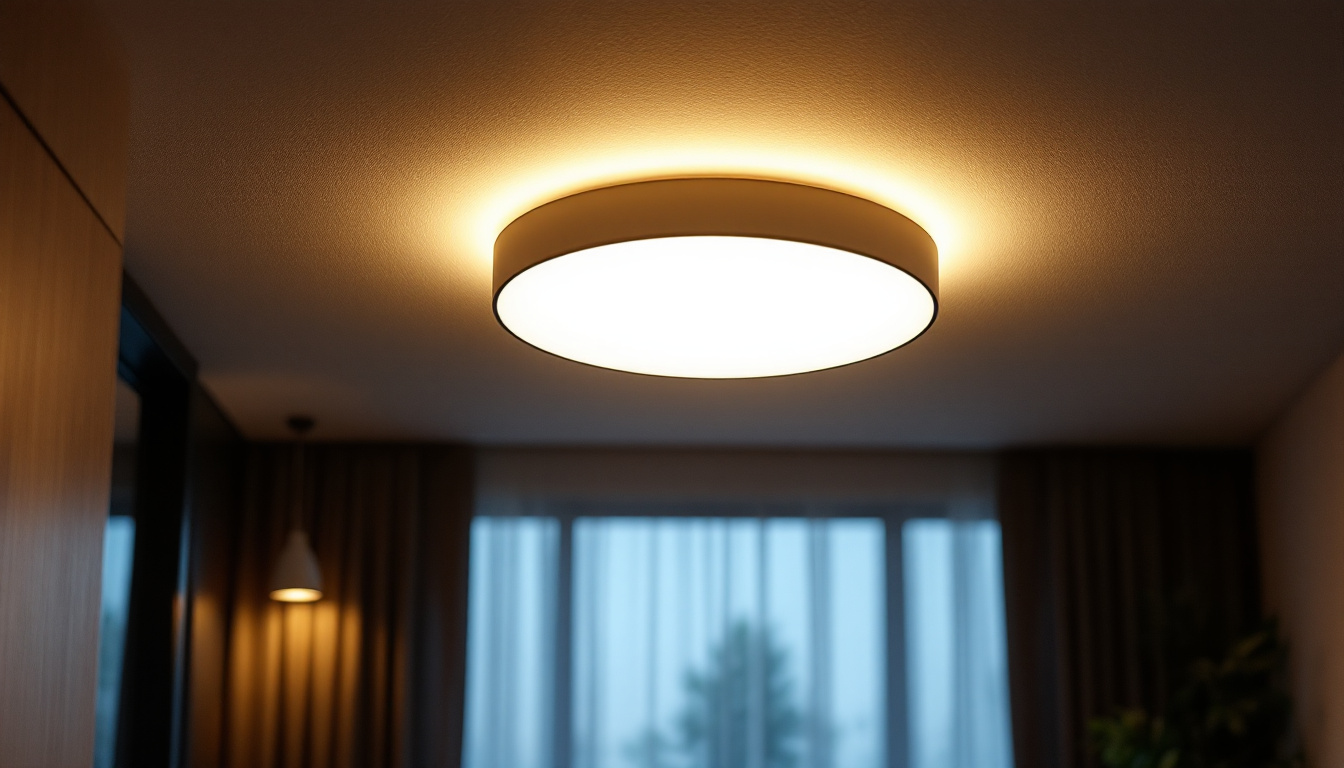
flush ceiling lights: Explained in 5 Minutes for Lighting Contractors
Flush ceiling lights are a popular choice in both residential and commercial spaces. Their sleek design and versatility make them an ideal solution for various lighting needs. This article aims to provide lighting contractors with a comprehensive understanding of flush ceiling lights, their types, installation techniques, and best practices for choosing the right fixtures for different applications.
Flush ceiling lights are mounted directly against the ceiling, offering a streamlined appearance that can complement various interior styles. Unlike pendant or chandelier fixtures, flush mounts do not hang down, making them suitable for spaces with low ceilings or where unobtrusive lighting is desired. This design not only maximizes headroom but also creates a clean and cohesive look that can enhance the overall ambiance of a room.
These fixtures come in various designs, sizes, and finishes, allowing contractors to select options that best fit the aesthetic and functional requirements of a project. Additionally, flush ceiling lights can accommodate different types of bulbs, including LED, incandescent, and fluorescent, providing flexibility in terms of energy efficiency and light quality. The ability to choose the right bulb type can significantly impact the warmth and brightness of the space, making it essential to consider the specific needs of the environment when selecting a flush mount fixture.
There are several types of flush ceiling lights, each serving unique purposes. Understanding these variations is crucial for lighting contractors to recommend appropriate fixtures to clients. Each type not only serves a functional role but also contributes to the aesthetic appeal of the space, making it important to choose wisely based on the intended use and design theme.
Standard flush mounts are the most common type of flush ceiling lights. They typically feature a simple design with a glass or plastic shade that diffuses light evenly across the room. These fixtures are ideal for general lighting in hallways, bedrooms, and living areas. Their versatility allows them to blend seamlessly into any decor, from minimalist to eclectic, while providing ample illumination for everyday activities.
low-profile fixtures are specifically designed for spaces with very low ceilings. They provide ample light without protruding too far from the ceiling, ensuring that headroom is maintained. These fixtures are often used in basements, closets, or any area where space is limited. Their sleek design not only prevents the risk of bumping into the light but also allows for creative placement in tight spots, maximizing the use of available space while maintaining a stylish look.
For those looking to add a touch of elegance to their space, decorative flush mounts are an excellent option. These fixtures come in various styles, from modern to traditional, and can feature intricate designs, materials, and finishes. They are perfect for entryways, dining rooms, or any area where aesthetics are a priority. The right decorative flush mount can serve as a statement piece, drawing the eye and enhancing the overall decor of the room. Moreover, many of these fixtures incorporate artistic elements such as stained glass or unique metalwork, allowing homeowners to express their personal style while benefiting from functional lighting.
Proper installation is essential for the functionality and safety of flush ceiling lights. Lighting contractors should be familiar with best practices to ensure a successful installation process.
Before beginning any installation, it is crucial to turn off the power at the circuit breaker to avoid any electrical hazards. Contractors should also use appropriate personal protective equipment, such as gloves and safety glasses, to ensure safety throughout the installation process.
Most flush ceiling lights come with a mounting bracket that should be securely attached to the ceiling. This bracket will hold the fixture in place and must be installed on a ceiling joist or a sturdy support structure. If the fixture is heavy, additional support may be necessary to prevent sagging or falling.
Once the bracket is securely in place, the next step involves connecting the wiring. Typically, this includes connecting the black (hot) wire, white (neutral) wire, and green or bare (ground) wire. It is essential to ensure that all connections are tight and secure to prevent electrical issues.
After the wiring is complete, the fixture can be attached to the mounting bracket. This usually involves aligning the fixture with the bracket and securing it with screws. Once the fixture is in place, the final step is to turn the power back on and test the light to ensure it functions correctly.
Selecting the appropriate flush ceiling light for a project involves considering several factors, including the space’s purpose, size, and desired ambiance. Lighting contractors should be equipped to guide clients through this decision-making process.
Understanding the space where the flush ceiling light will be installed is critical. Factors such as ceiling height, room dimensions, and existing decor can influence the choice of fixture. For example, in a small room with low ceilings, a low-profile fixture may be the best option, while a larger decorative flush mount could enhance the aesthetic of a spacious entryway.
The amount of light required in a space is another important consideration. Contractors should assess the room’s function to determine the appropriate brightness level. For instance, a kitchen may require brighter lighting for cooking tasks, while a bedroom may benefit from softer, ambient light.
When selecting fixtures, it is essential to consider the lumen output and the type of bulb used. LED bulbs, for example, offer higher lumen output with lower energy consumption, making them a popular choice for flush ceiling lights.
The style of the flush ceiling light should harmonize with the overall design theme of the space. Contractors should consider the color scheme, materials, and architectural features present in the room. A well-chosen fixture can serve as a focal point, enhancing the room’s aesthetic appeal.
Additionally, contractors should be aware of the latest trends in lighting design. For example, minimalist and industrial styles are gaining popularity, and flush mounts that reflect these trends can attract clients looking for modern solutions.
In today’s environmentally conscious market, energy efficiency is a significant selling point for lighting fixtures. Flush ceiling lights can play a vital role in reducing energy consumption and promoting sustainability.
LED bulbs are a popular choice for flush ceiling lights due to their energy efficiency and longevity. Compared to traditional incandescent bulbs, LEDs use significantly less energy and have a much longer lifespan, reducing the frequency of replacements and overall energy costs.
Contractors should educate clients on the benefits of LED technology, including lower heat output, which can contribute to a cooler indoor environment and reduced air conditioning costs.
Integrating smart technology into flush ceiling lights is another way to enhance energy efficiency. Smart bulbs and fixtures allow users to control lighting remotely, set schedules, and adjust brightness levels according to their needs. This level of control can lead to significant energy savings and increased convenience for homeowners.
Contractors should stay informed about the latest smart lighting products and be prepared to recommend compatible fixtures to clients interested in modernizing their lighting systems.
Even experienced lighting contractors can make mistakes during the selection and installation of flush ceiling lights. Being aware of common pitfalls can help ensure a smoother process and greater client satisfaction.
One of the most common mistakes is failing to assess the lighting needs of a space adequately. Contractors should take the time to evaluate the room’s function, size, and existing light sources to determine the appropriate fixture type and brightness level. Inadequate lighting can lead to dissatisfaction and may require additional fixtures to rectify the issue.
Another frequent oversight is neglecting to consider ceiling height when selecting flush ceiling lights. In spaces with low ceilings, installing a fixture that hangs too low can create a hazard and make the room feel cramped. Conversely, a fixture that is too small for a high ceiling may not provide sufficient light. Proper assessment of ceiling height is essential for achieving the right balance.
Choosing a flush ceiling light that does not match the room’s decor can detract from the overall design. Contractors should ensure that the selected fixture complements the existing style and enhances the space’s visual appeal. Taking the time to consider aesthetics can lead to more satisfied clients and successful projects.
Flush ceiling lights are a versatile and practical lighting solution for various applications. By understanding the different types of fixtures, installation techniques, and selection criteria, lighting contractors can provide valuable guidance to clients seeking the perfect lighting solution. With an emphasis on energy efficiency and design compatibility, contractors can enhance their service offerings and contribute to the growing trend of sustainable and stylish lighting solutions.
As the demand for flush ceiling lights continues to rise, staying informed about the latest trends and technologies will be essential for contractors looking to thrive in the competitive lighting industry. By equipping themselves with knowledge and expertise, lighting contractors can ensure they meet the diverse needs of their clients and create beautifully illuminated spaces.
Ready to elevate your lighting projects with the finest flush ceiling lights on the market? Look no further than LumenWholesale, where we specialize in providing contractors with high-quality, specification-grade lighting solutions at unbeatable wholesale prices. Our commitment to cutting out the middleman means you enjoy superior products without the inflated markups, ensuring your projects shine with reliability and performance. With our vast selection that meets rigorous industry standards and the convenience of free shipping on bulk orders, you can trust LumenWholesale to deliver the best value in lighting. Don’t compromise on quality or cost. Discover wholesale lighting at the best value today and light up your spaces with confidence and style.

Discover the top strategies lighting contractors use for ceiling mount light fixtures.

Discover the ultimate guide for lighting contractors on exterior LED can lights.

Discover the essential resources lighting contractors rely on to master motion sensor flood lights.

Discover how the best automotive shop wall lights are revolutionizing the workspace for lighting contractors.